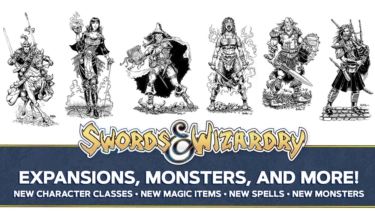
Publisher: Gary Games
Designers: Robert Dougherty, John Fiorillo, Justin Gary, and Brian M. Kibler
Artist: Eric Sabee
Year: 2010
Players: Two to four players
Ages: 12+
Playing Time: 30 to 45 minutes
Genre: Fantasy deck building card game
MSRP: $39.99
Ascension: Chronicle of the Godslayer is a thematic deck building game set in the fantasy world of Vigil, in which your goal is to raise an army to battle evil followers of the god Samael and destroy the Great Seal before he can return. If you’ve played Dominion, or just about any other of the deck building games out many concepts and mechanics will be pretty familiar As you begin your ten card deck will be fairly weak, to say the least, but as the game progresses you’ll have the chance to play action cards as well as reveal currency from your hand of five cards so you’ll be able to add new cards to your deck. These cards can grant more currency, more powerful actions, and gain you points.
The presentation for Ascension is top notch as the cards are all nice stock and the components included are well done also. Some folks will dig the art, although I’ve heard from a few people that they don’t care for it, but I personally thought it was just fine and serviceable. Just don’t go into the game expecting L5R or Magic: The Gathering masterpieces on every card and you won’t be disappointed. All in all Gary Games has done a nice job with the title, in my opinion.

Multiple currencies come into play in Ascension. First are the Runes and these are used to purchase new heroes and technology. Power is how you go about attacking and destroying monsters. Finally there are Points, which are represented by icons located on the cards you purchase as well as gems that you receive upon defeating certain monsters. Points effectively break down into victory points all in all. Three types of cards are included in Ascension: Monsters, Heroes, and Constructs. Monsters are the vile followers of Samael you’ll be looking to defeat, Heroes add to your ability to whack those monsters around, and Constructs represent devices and magical items that can come into play. Any of these cards can also include special bonuses as well. Heroes are only active for the duration of the turn in which they are played while Constructs remain active until removed, usually due to an enemy attack.
Setting up a game of Ascension is not the same old same old either as there are no set decks to be randomized to begin the game. So instead of stacks of particular cards to be made available in the current game (while others are removed from play) everything comes directly from a single deck known as the Portal. Monsters, Heroes, Constructs all form this one Portal deck. This makes for setting up the game a snap as you don’t need to sort through all the cards to return them to their respective decks. Each player begins the game with eight apprentice cards and two militia cards. Let’s just say you’ll look to get better cards ASAP since these really are weaklings.

A predetermined number of Honor tokens are placed in a pool, the amount of which depends on the number of players, to be drawn from as the game progresses. Once the pool of gemstones runs out, the game ends as soon as all players have completed their turn for the round. At this point all the gemstones are counted up and all cards in you possession, i.e. in your deck and discard pile are totaled for Honor points and the person with the most points is declared the winner.
In playing Ascension I find it to be fast paced and easily accessible to new players with a very short learning curve. If you’re looking for a deck builder that’s easy to get into with a fantasy theme and background you’ll want to give the game a look. That isn’t to say I don’t see problems with the game itself as a title that you’ll be pulling off the shelf all the time to get in a few plays with your pals though as two issues come directly to mind.
The first is the fact that there isn’t much as to concocting a long term strategy in any given session. Whereas many deck builders have specific cards that will be available in the game, normally a set of ten randomly selected decks, everything is already piled into the one Portal deck in Ascension. With random decks you come to understand what’s available and how you might be able to construct a winning combination of cards to take you through to the end of the game. The case here is everything is conceivably in play so if the center row doesn’t contain anything worthwhile when your turn rolls around you’re pretty much out of luck. I’m sure plenty of people, who play Ascension regularly, will point me in the direction of how to hone a winning strategy but for those getting in the first few plays everything comes across as by the seat of your pants.

You also may encounter turns in which all you have in hand are attack cards with nothing outside of the wimpy side Cultists to attack while other times all the center row features are monsters but you have five currency cards in front of you. At these times you’re stuck dealing with the side cards such as Mystics, Heavy Militia, and Cultists. Granted, this won’t happen too much of the time but just often enough for you to have the feeling that a turn or two each game you did nothing more than spin your wheels…
The second issue I have, and this is more of a personal preference thing, is the lack of player interaction within the game. Truth be told Dominion, as well as many other deck builders, suffer from this as well. You almost feel as if you’re playing a multiplayer game in a vacuum as very little you’ll do has any effect on the other players. From time to time you might defeat a monster which then allows you to banish a card from the center row, force a player to discard a Construct, or even steal a card from another player. All this does is remove a card that another player might be looking to get their hands on – or taking it out their hand – but outside of that you’re simply focused on the six cards in the center row. This doesn’t make Ascension a bad game by any stretch but it is worth pointing out since I enjoy games that present a more direct way to influence the other people sitting around the table.
To sum things up, if you’re a fan of Dominion, or have been looking to get into a lighter deck builder with a fantasy theme, I’m sure you’re going to enjoy Ascension. It might not be the smoothest deck builder out there when it comes to mechanics – although I’m reviewing the first base game so a lot may have changed with the expansions – but there is a good dose of flavor, theme, and monster bashing you won’t find elsewhere.
- Paizo Preview April 2024 - Apr 19, 2024
- Broken Weave for 5E is Out in PDF - Apr 19, 2024
- Score Big Savings with the Ars Magica 5E Bundle of Holding - Apr 19, 2024













